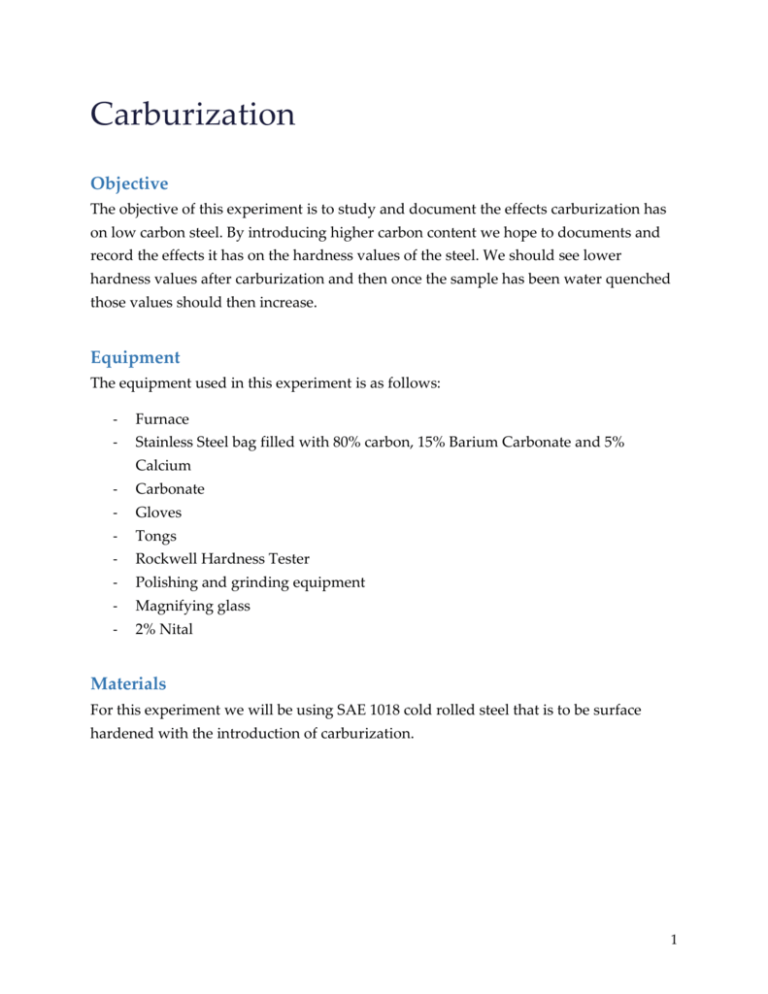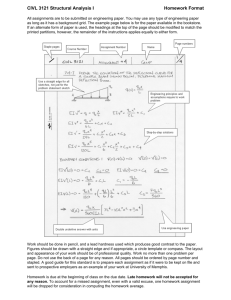File
advertisement

Carburization Objective The objective of this experiment is to study and document the effects carburization has on low carbon steel. By introducing higher carbon content we hope to documents and record the effects it has on the hardness values of the steel. We should see lower hardness values after carburization and then once the sample has been water quenched those values should then increase. Equipment The equipment used in this experiment is as follows: - Furnace - Stainless Steel bag filled with 80% carbon, 15% Barium Carbonate and 5% Calcium - Carbonate - Gloves - Tongs - Rockwell Hardness Tester - Polishing and grinding equipment - Magnifying glass - 2% Nital Materials For this experiment we will be using SAE 1018 cold rolled steel that is to be surface hardened with the introduction of carburization. 1 Procedure Week One 1. Our first step in this procedure is to pre heat our furnace to 930℃ for use later 2. Next we need to identify a common face on the sample so that testing can occur and be documented. Notch or etch the sample for identification using the equipment available. 3. While the furnace is pre heating take the sample and test every side for their respective hardness values. Record these results and be sure to take the average of the readings as results can vary. 4. Once hardness testing is complete and the furnace is full heated, we will then place our sample in our stainless steel bag. This bag contains 80% carbon, 15% Barium Carbonate and 5% Calcium to introduce carburization to the sample. The bag is then to be folded and sealed. 5. Next we are to place the bag in the furnace for about 16 hours and record the amount of time the sample underwent treatment. 6. Lastly, after the total treatment time has elapsed, remove the bag and allow the sample to cool and anneal. Week Two 1. First step is to remove the specimen from the bag and brush off any excess carbon. 2. Using our Rockwell Hardness Tester, we are to record the hardness values for each side, again record the average each side due to varying records. 3. Pre heat the oven again but this time only to 750℃ 4. While the oven preheats, using a cut-off saw cut your sample in half so that it can be placed in the furnace. 5. Place the half in to the furnace for 50 minutes. Once done, using gloves and tongs, water quench the sample for 10 seconds. 6. Polish and etch that half of the sample using 2% Nital so that the microstructure can be observed using a magnifying glass. 7. Observe and record what you notice about the sample after carburization and quenching. 8. Lastly, preform another round of hardness tests on the surface and the middle of the etched piece and record the results. 2 Results Hardness Test – Pre Carburization Sample Side 1 2 3 4 5 6 Result - HR15TW 88.03 88.91 88.38 89.87 91.43 87.74 Post Carburization Sample Side 1 2 3 4 5 6 Result - HR15TW 87.73 86.67 82.03 82.30 83.64 85.77 Etched Side – Water Quenched Sample Side 1 2 3 4 5 Inside Result – HR15TW 90.72 86.44 89.81 85.34 93.49 87.74 Analysis of Results Carburizing is the heat treatment process in which iron or steel absorbs more carbon in order to gain more hardness. Depending on the length of time in which the sample is exposed to heat and based on that temperature will determine how much carbon can diffuse in the metal. 3 As we can see from our results, the average hardness is slightly lower after the heat treatment because any stresses in the metal previously had been released through annealing. Its once the piece is cut reheated and water quenched where we really see the true benefit of carburization as the surface is hardened and the center is more ductile. This outcome is achieved because of the transformation to Martensite at the surface and the center remains soft because of its pearlite microstructure. After an examination of our part, we found that the surfaces structure was different to the center and thus the heat treatment had worked. Conclusion The intention of this lab was to introduce the Carburization heat treatment process. This is the process of surface hardening a cold rolled steel sample while maintaining ductility in the core. We achieved this result by the following procedure: - Hardness tested the sample prior to heat treatment - Etched the sample and then added it to a bag containing 80% carbon, 15% Barium Carbonate and 5% Calcium - We then let the sample anneal and cool, then recorded hardness results again - Cut the sample in half to expose the center, reheated the sample and water quenched - Recorded our final set of hardness data The secondary hardness values reflected slightly lower than before because of the annealing. This is seen with a hardness of 89.87HR15 on side 4 but then lowering to 82.30HR15. After water quenching the half we can see that the surface is again harder but with a ductile core. To conclude the sample was successfully heat-treated and the desired outcome was achieved. 4



